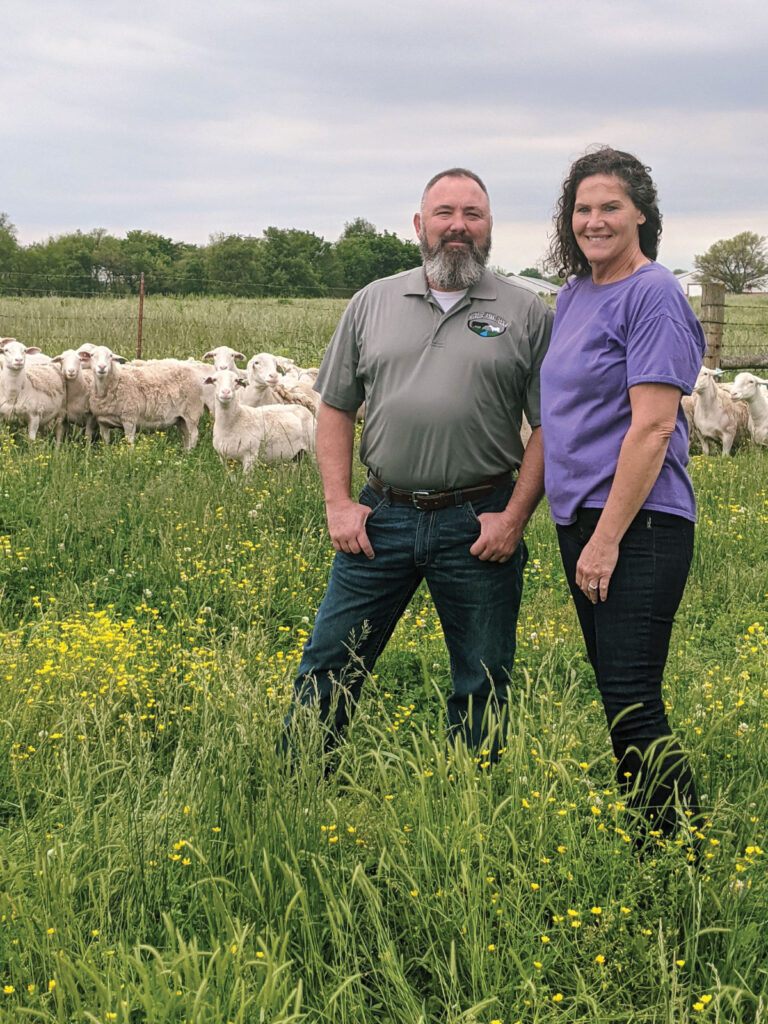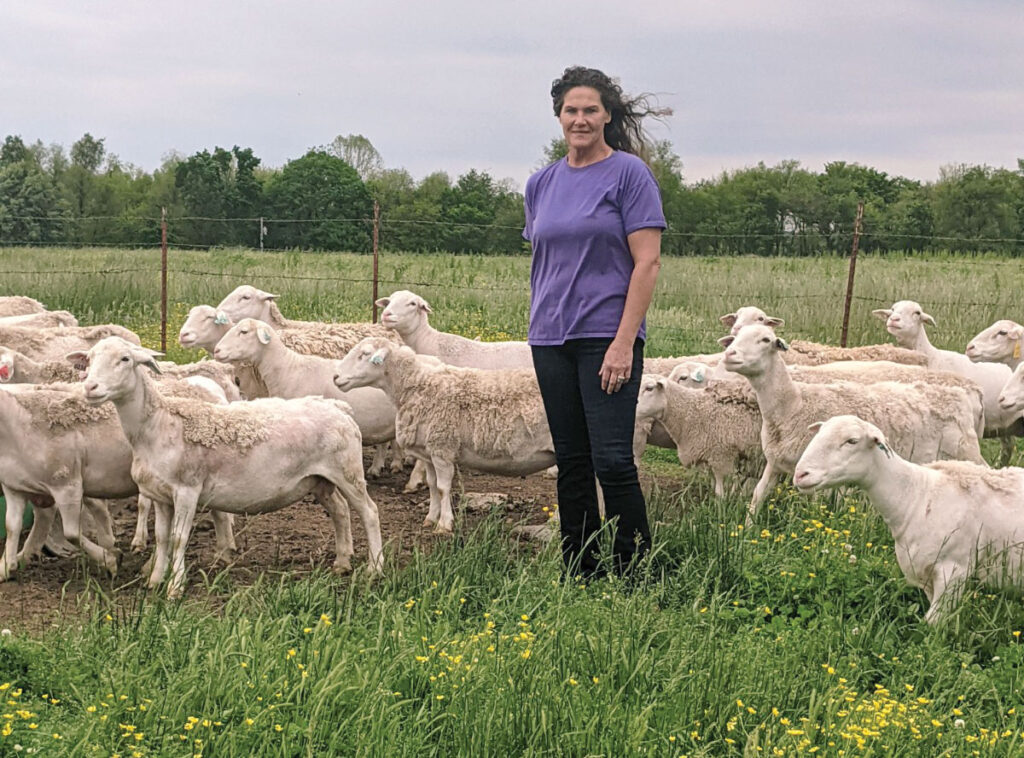
The Teafatiller family work to raise Dorper and White Dorper sheep for shows and production
SILOAM SPRINGS, ARK. – Three generations, 100 ewes and close to 120 cows share the same land, all hands have to be on deck to make a farm function.
Thomas and Roxanna Teafatiller as well as their adult daughter Tiffany, three school age daughters and two grandchildren live on 260 acres with 120 around the farmhouse and 140 acres of Illinois River bottom ground in Siloam Springs, Ark.
Thomas is an electrical engineer who has worked for Reliability First for three years as a principal protection engineer while both his wife Roxanna and their daughter Tiffany are nurses, with Roxanna serving as an area manager of clinical services for 17 facilities of DaVita Dialysis. Tiffany works weekends at a hospital and on the farm the other days of the week while. Meanwhile, their son William is a pastor in Carthage, Mo., with an additional three grandchildren.
Coyote Creek Farms is all about family with the children and grandchildren showing registered sheep and cattle as well as owning Dorper or White Dorper ewes.
“The idea is to teach all of the youngsters responsibility and where money comes from,” Thomas said. “The show animals do well with the kids earning money from shows and sales. Their responsibility is to pay us back for all entry fees and some of the feed costs with the rest of their earnings going into their savings accounts. We limit ownership to two ewes apiece because that is the maximum we can handle with everything else we do.”
A significant farm goal is to raise quality production livestock with little medical, chemical or supplemental intervention. Nonetheless, quality and compassion lead to the use of a vaccination protocol for all stock twice a year, with wormers and other medical interventions as needed for individuals because seeing an animal suffer unnecessarily is unacceptable.
Thomas was raised on a farm and Roxanna was raised on a Kansas ranch. To this day, Thomas and Roxanna carry their love of animals as well as their love of family even as they pursue careers.

Their Dorper and White Dorper sheep are hair sheep used for meat rather than wool with Dorper and White Dorper rams being popular with commercial breeders. Dorper meatiness and growth rate transfer to the young so that commercial breeders can sell lambs more quickly and increase profits. All farm sheep are raised around the farmhouse to decrease coyote predation.
Teafatiller ewes are bred naturally by seven rams who wear a breeding harness with a square “crayon” to mark each ewe when she is covered, starting with lighter colors and changing to darker ones as the breeding season continues. The practice allows the Teafatillers to determine if a ewe cycled and did not breed. The farm produces 50 to 60 percent multiple births with occasional triplets. Lambs are sold at Dorper association breed shows. Many don’t realize sheep can lamb as many as three times in two years. Therefore, those who stay on the farm are culled even harder than the cattle in order to keep numbers manageable.
Because small ruminants are particularly susceptible to parasites, the FAMACHA scoring system is used to check the eyelids of each ewe are inspected when the herd is worked and in between times, if necessary. The system checks for anemia, an indication of a worm issue. That ewe is then immediately treated. Another practice to limit parasite incursions is to rotate pastures every week or so. Frequent deworming of an animal is an essential culling criterion that promotes worm resistance within the herd. The culled sheep and lambs, sold in Diamond, Mo., or Leach, Okla., are generally not show quality but still excellent for commercial herds and meat. Any lamb that has a structural issue is finished out and consumed on the farm.
The Teafatiller cattle herd is divided by location. The river bottom cattle are commercial and are heavily SimAngus influenced with replacements coming from their registered Simmental herd by the farmhouse. Heifers not fitting current show preferences become part of the commercial herd so that herd quality and production are constantly improving with an ultimate goal of having 75 percent of their total cattle herd being registered. Choosing Simmental as the dominant herd comes from Thomas’ childhood when his uncle David showed Simmentals, then large red and white animals. Because of breed changes, they can now also be black, the farm color of choice due to consumer preferences.
Part of the 50-plus cows by the farmhouse are registered Simmental with the remainder being embryo transplant recips from eggs flushed from the cows on the farm and embryos purchased off the farm. Roxanna AIs the Simmental females with a conception rate of 65 to 70 percent. The high-quality registered females are synced up using a timed AI protocol; if they miss conceiving during this cycle, they are AI bred the next heat cycle using observed heat. They are then put with one the registered Simmental bulls raised on the farm. They purchase semen from the same businesses with calving ease, growth and production longevity being the dominating criteria. Since the main purpose of the registered herd is to supply show animals for the farm-based youngsters, herd size remains stable with replacement heifers coming from the farm and some breeding stock sales. Four heifers and two steers will show this year at four or five shows within the state.
Part of the river bottom land where the commercial cattle are kept is located in the flood plain meaning fences are washed away quite frequently.
“I think the most important technology on our place is our electric fences because they are easy to put back together when flooded out,” Roxanna explained. “However, record keeping software comes in as a close second”
In spite of off-the-farm jobs, farm work and shows, the family does find time to relax. Hanging out, kayaking and grilling at the river and are favorite activities. While Thanksgivings are held at the farmstead, Christmas celebrations “hop” around, changing every couple of years so each family has a chance to share the holiday at home.
“Living on this beautiful land and sharing it with family is the moving force behind everything we do,” Thomas said. “Our agricultural lifestyle is the reward for the work we do off the farm.”







